Regulatory Horizon Scanning Software for Real-Time Compliance
Regulatory Horizon Scanning Software streamlines compliance with real-time monitoring, rapid alerts, multilingual coverage, and GRC integration. Stay ahead of complex global rules, mitigate risks, and maintain trust in a constantly evolving regulatory landscape
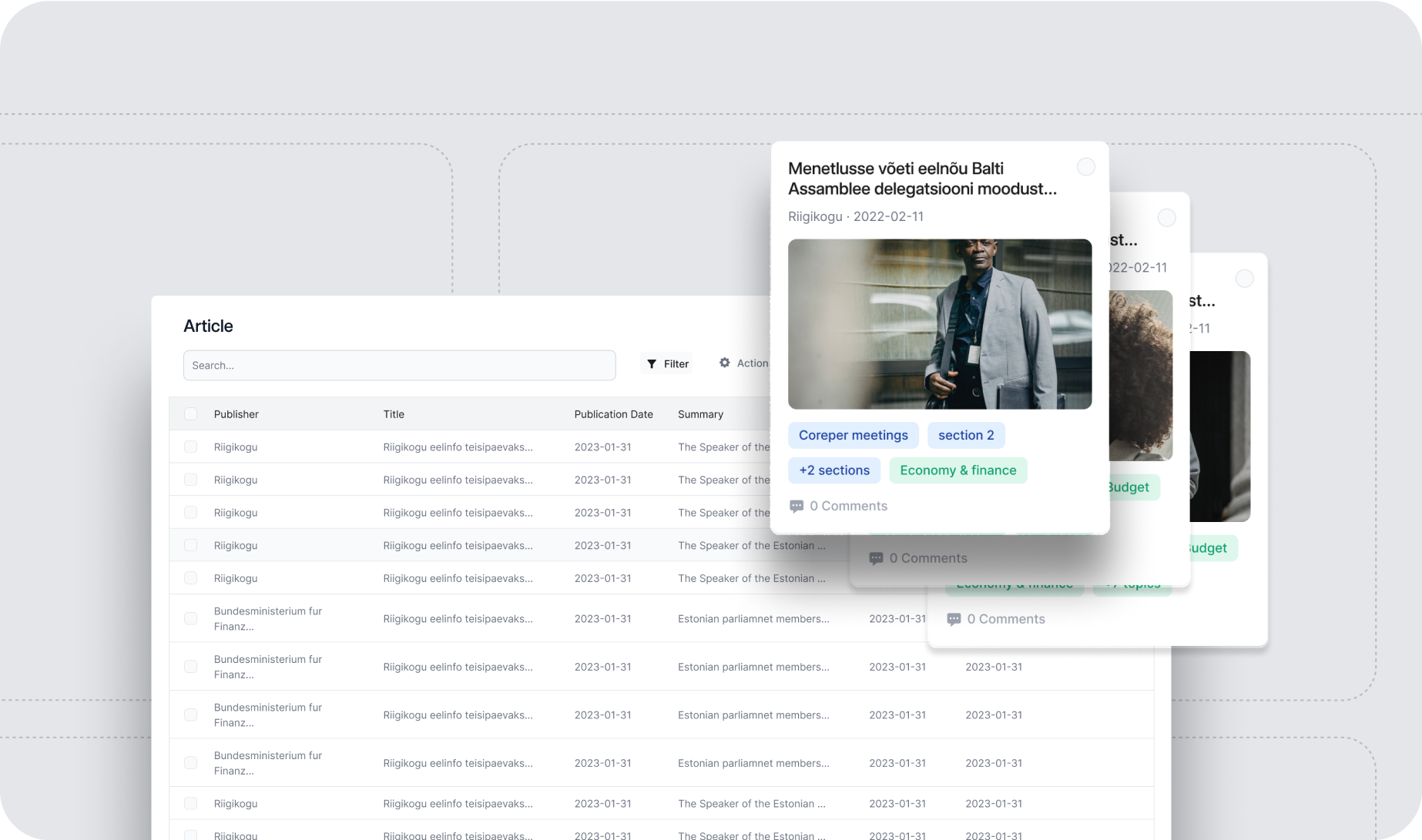
In today’s global business environment, regulations can shift overnight, radically altering the compliance landscape. Governments, industry watchdogs, and international agencies continuously release new laws or update existing ones. A single oversight—missing just one key rule—can lead to millions in penalties, disrupt operations, or even tarnish brand reputation.
That’s where Regulatory Horizon Scanning Software comes in. These systems provide immediate visibility into emerging rules, ensuring you’re always one step ahead of compliance threats.
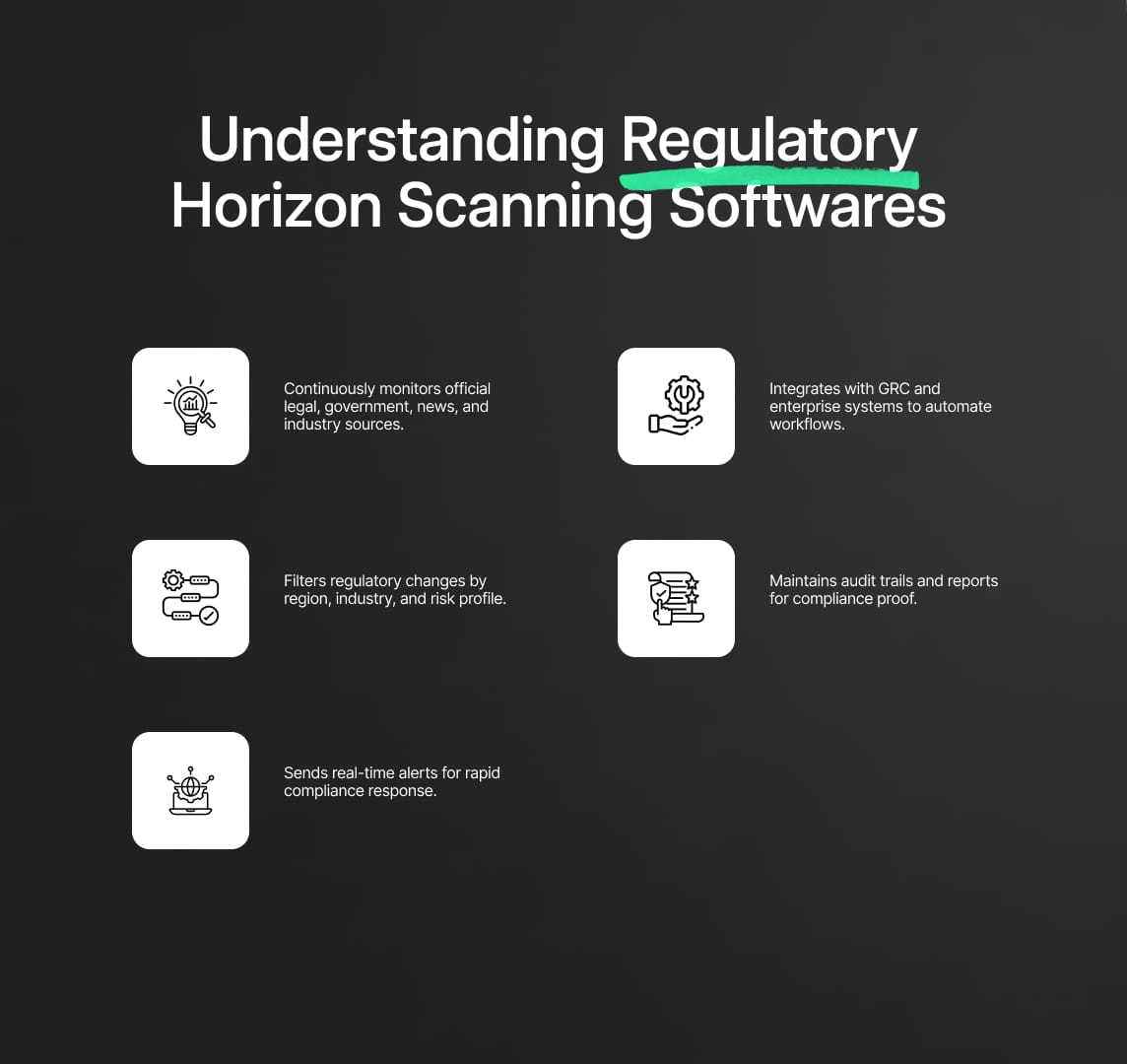
Understanding Regulatory Horizon Scanning Softwares
Before we explore how these platforms strengthen compliance, let’s define what they actually are.
Regulatory Horizon Scanning Software (RHSS) is a specialised technology solution that:
- Monitors official legal websites, government portals, news outlets, and industry publications around the clock.
- Aggregates and filters relevant regulatory changes according to your organization’s region, industry, and risk profile.
- Delivers real-time alerts and updates so that compliance teams can respond swiftly.
- Integrates with Governance, Risk, and Compliance (GRC) or enterprise software, reducing silos and automating compliance-related workflows.
- Provides audit trails, historical logs, and sophisticated reporting to demonstrate proof of compliance.
By transforming manual tracking and sporadic auditing into a 24/7, data-driven process, RHSS helps you adapt to complex, evolving regulations with unprecedented speed and accuracy.
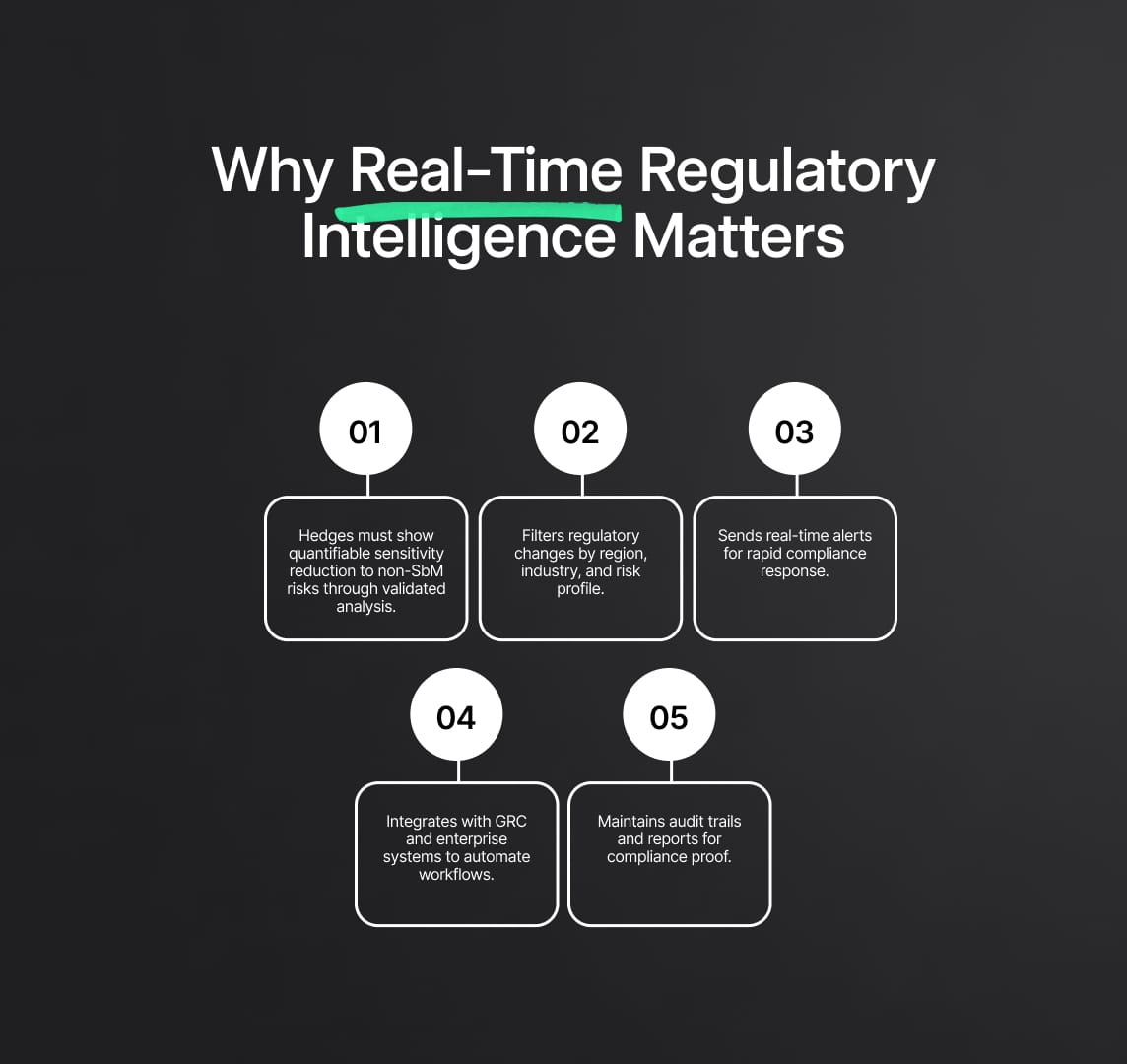
2. Why Real-Time Regulatory Intelligence Matters
2.1. The High Cost of Non-Compliance
Organizations that fail to adapt to legal changes swiftly risk substantial fines, business interruptions, and increased regulatory scrutiny. Financial costs may hit millions in direct penalties, and the indirect harm of losing customers or tarnishing your brand often proves even more expensive.
2.2. Legal and Operational Certainty
Having an up-to-the-minute view of new rules ensures operations stay uninterrupted. Teams can act preemptively—updating policies, training staff, and adjusting workflows—rather than scrambling to adapt after regulations take effect.
2.3. Maintaining Stakeholder Trust
From shareholders and clients to business partners and regulators, external parties expect transparency and compliance assurance. By being visibly on top of new mandates, you cement your organization’s reputation as trustworthy and responsible.
3. Core Functions of Regulatory Horizon Scanning Systems
Modern Regulatory Horizon Scanning Software solutions typically offer a suite of features designed to capture, analyze, and channel relevant regulatory data to the right people—at precisely the right time. Here’s a closer look at the foundational elements.
3.1. Continuous, Global Monitoring
Experience tells us that rules can emerge at any moment—sometimes without prior notice. RHSS acts as a constant sentry, scanning:
- Official Legislative Websites and Government Portals: For instance, the European Commission, U.S. Federal Register, or local agencies like BaFin in Germany.
- Industry Bodies and Associations: Monitoring specialized regulations—for example, pharmaceuticals tracking FDA updates or financial institutions following banking authorities.
- Media Outlets and Policy Think Tanks: Capturing discussion around upcoming legislative changes to provide early alerts.
- Social Media Channels: Gathering additional signals where regulators and industry experts often share insights in real time.
By tracking these diverse sources simultaneously, organizations can avoid blind spots and immediately flag relevant shifts in compliance requirements.
3.2. Advanced Data Processing and Categorization
Once the software collects vast amounts of information, machine learning and AI-driven processes sift through it to:
- Filter Out Irrelevant Updates: Minor policy tweaks with no direct impact on your sector are removed from your feed.
- Tag and Categorize: Each change is labeled by region, industry, level of urgency, or potential risk, delivering a tailored view of critical updates.
- Consolidate Overlapping Notices: If multiple sources report on the same directive, the software merges them to avoid repetition and confusion.
This ensures your compliance team isn’t overwhelmed by a flood of raw data—instead, they receive highly pertinent notifications that demand action.
3.3. Immediate Alerts and Customisable Notifications
Authoritativeness in compliance hinges on speed and precision. Accordingly, horizon scanning tools offer:
- Real-Time Alerts: Send emails, SMS messages, or notifications in collaboration platforms (e.g., Slack, Microsoft Teams) the moment a new or modified rule is detected.
- Customized Watchlists: Compliance officers can specify keywords, risk levels, or jurisdictions, ensuring they only receive the updates that genuinely matter.
- Escalation Paths: If a high-impact rule is not acknowledged within a set timeframe, additional team members or higher-level managers are alerted automatically.
This streamlines organizational communication and keeps mission-critical changes from falling through the cracks.
3.4. Integration with GRC and Enterprise Systems
Trustworthiness comes from consistent, organization-wide adherence to compliance protocols. RHSS optimizes this by:
- Plugging into GRC Suites: Automatically updating your risk registers, compliance checklists, or internal policy repositories whenever a relevant regulatory update is confirmed.
- Linking to ERP/CRM: Ensuring that procurement, logistics, or sales processes instantly align with new legal requirements.
- Bidirectional Data Flow: In some solutions, feedback from internal systems (e.g., policy changes you make) can inform the scanning tool, refining which updates are most relevant next time.
The result? No more silos, reduced manual effort, and smoother collaboration across departments—critical for ensuring compliance is embedded throughout your corporate structure.
3.5. Comprehensive Reporting and Audit Trails
Demonstrating experience and expertise in compliance often boils down to your ability to prove you’ve addressed every regulatory shift responsibly. RHSS typically includes:
- Logging of All Updates: Each detected change is timestamped and recorded alongside user actions (e.g., who reviewed it, what policy updates were made).
- Automated Summaries: Generate monthly or quarterly digest reports that highlight key issues, the departments impacted, and the steps taken to achieve compliance.
- On-Demand Audit Support: Should regulators query your practices, you can instantly provide historical compliance records, showing exactly how and when changes were adopted.
Such transparent documentation streamlines audits, fosters internal accountability, and reassures external stakeholders that you’re consistently monitoring and adapting to regulatory developments.
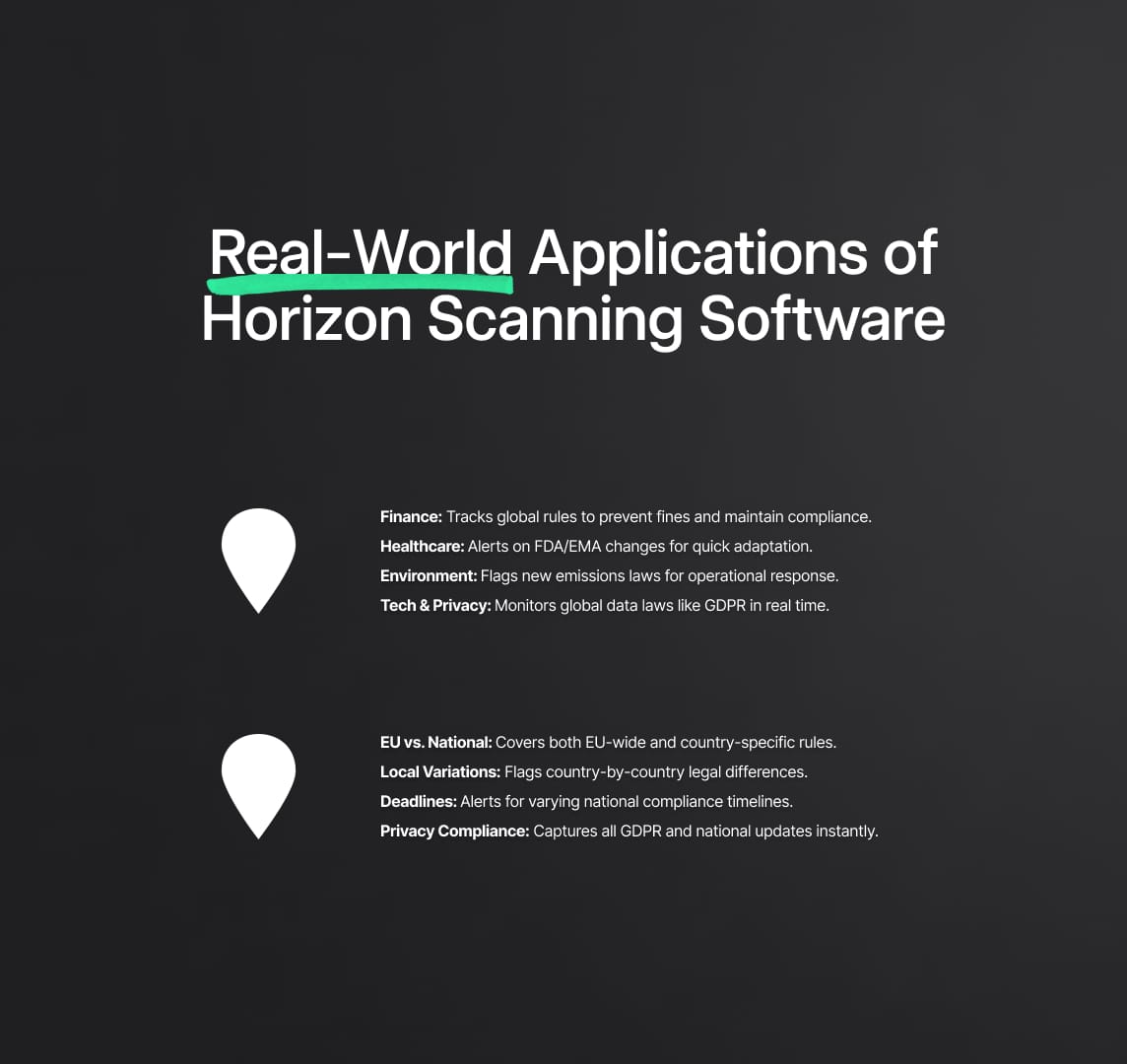
4. Real-World Applications of Horizon Scanning Software
4.1. Financial Services
Banks, insurers, and credit providers face a barrage of mandates—from anti-money laundering rules to capital adequacy and customer protection standards. Missing a single update can mean huge fines and reputational fallout. Horizon scanning tools help them stay aligned across multiple jurisdictions, ensuring critical directives like those from the Basel Committee, European Banking Authority, or the SEC are never overlooked.
4.2. Healthcare and Pharmaceuticals
Hospitals juggle patient data protection regulations, while pharma companies track drug approval pathways and safety protocols. With a global horizon scanning system, an American pharmaceutical firm can instantly learn about new EMA (European Medicines Agency) guidelines or FDA changes—even if they happen in the middle of the night—leading to faster procedural updates and consistent compliance.
4.3. Environmental and Sustainability
The world’s climate crisis has accelerated new policies targeting emissions, waste management, and carbon footprints. Manufacturers and energy companies leverage horizon scanning to quickly react when a region tightens environmental laws, adjusting operations, meeting emission deadlines, and capitalizing on green incentives.
4.4. Technology and Data Privacy
From the General Data Protection Regulation (GDPR) in Europe to evolving privacy frameworks in Asia and North America, tech firms face a patchwork of complex data rules. Real-time alerts ensure software developers, data scientists, and IT security teams update systems or user consent mechanisms before new laws go into effect.
5. The European Complexity: Navigating Layered Frameworks
Europe’s regulatory climate is famously intricate—and for good reason. While the European Union (EU) strives to maintain a harmonized internal market through directives and regulations (e.g., MiFID II in finance or MDR in medical devices), the implementation and enforcement of these rules can vary widely from one member state to another. Beyond the EU, non-member European countries such as Norway or Switzerland often align with certain EU policies yet retain their own distinct legal requirements.
This patchwork of pan-European and national mandates creates a maze of compliance challenges. A single directive may have 28 different local variations, each with its own deadlines, processes, and interpretations. Consequently, businesses that operate across multiple countries must contend with simultaneous, but often inconsistent, rules.
5.1 Why This Complexity Demands Horizon Scanning
- Simultaneous Monitoring of Multi-Tier Regulations
- EU-Level vs. National Frameworks: A directive like MiFID II establishes unified standards for financial services. However, Germany may adopt subtle operational clauses that differ from those in France or Spain. RHSS tools watch both Brussels-level decisions and local legislative portals, ensuring you never miss an important variation.
- Non-EU European Laws: Countries outside the EU often take a “pick and choose” approach, adopting some EU rules while enforcing their own parallel regulations. Horizon scanning solutions capture all relevant information, providing a holistic view of each jurisdiction’s unique stance.
- Localization and Multilingual Support
- Immediate Clarity in Multiple Languages: Official communications in the EU can be published in 24+ languages. Missing an update because it’s published in a language you don’t track can cause delays or outright non-compliance. RHSS platforms with built-in translation capabilities ensure regional teams instantly understand new directives, eliminating language barriers.
- Cultural Nuances in Implementation: Some nations, like Germany or Denmark, may interpret EU guidelines more strictly, while others might adopt a more flexible approach. Horizon scanning software highlights these cultural and legal nuances, helping you align corporate policies with the expectations of local regulators and stakeholders.
- Tailored Compliance Paths for Each Country
- Identifying Subtle Differences: While EU regulations aim to unify the market, national regulators still issue technical guidelines or country-specific amendments. For instance, GDPR is EU-wide, but enforcement priorities or data-processing rules can differ in Italy compared to the Netherlands. RHSS alerts you to these disparities, so compliance teams can implement tailored policies instead of taking a one-size-fits-all approach.
- Avoiding Overlooked Deadlines: Different member states might impose unique compliance timelines for adopting new rules. Horizon scanning tools keep track of each country’s effective dates, ensuring you meet all deadlines—whether it’s a phased rollout in Belgium or immediate enforcement in Austria.
How This Drives Business Value
By customizing compliance strategies across Europe’s diverse legal tapestry, organizations not only prevent violations but also gain a competitive edge. When you can confidently expand into new markets or scale existing European operations without stumbling over unforeseen rules, you protect revenue streams, bolster brand reputation, and strengthen stakeholder relationships.
5.2. Example: GDPR Updates
A prominent illustration of Europe’s layered system is the General Data Protection Regulation (GDPR). Enforced in 2018 to harmonize data privacy standards across the EU, GDPR provides a common framework, but each member state wields a degree of latitude. Regulators can issue local guidance documents, clarifications, or additional requirements—ranging from nuanced data breach reporting obligations to region-specific rules for cross-border data flows.
- National Authority Variations: In Spain, for instance, the AEPD (Agencia Española de Protección de Datos) might issue strict fines for even minor infractions, while other countries might initially focus on major infractions.
- Guidance and Updates: The EU’s European Data Protection Board (EDPB) continually releases guidance that can impact how GDPR articles are interpreted. A horizon scanning system swiftly flags these updates, prompting data protection officers to revise internal policies and employee training materials.
With RHSS in place, you automatically track both EU-level guidance and member-state regulations. This ensures a swift reaction to evolving data protection rules—keeping your privacy program robust, transparent, and fully compliant, no matter where in Europe you do business.
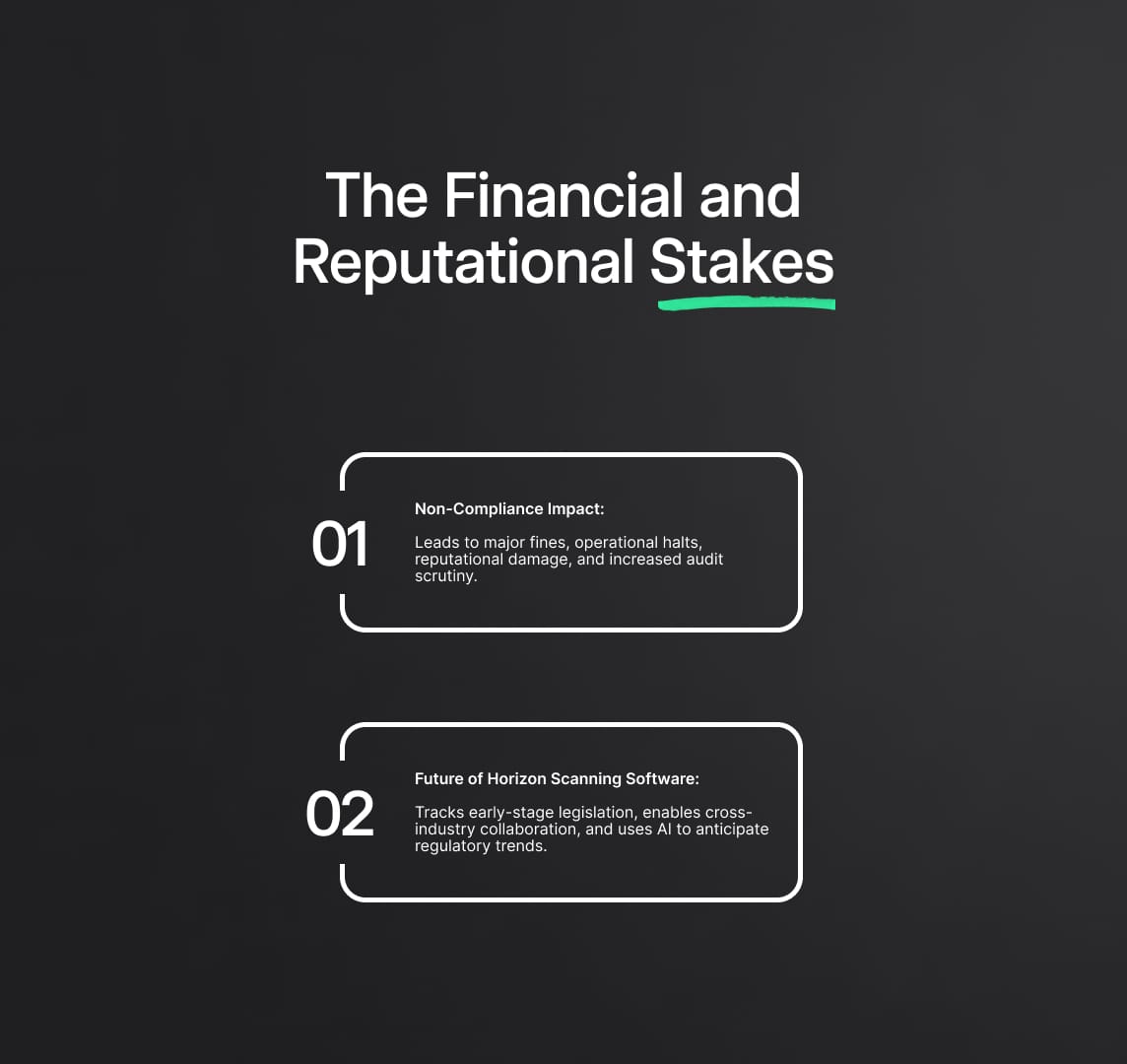
6. The Financial and Reputational Stakes
6.1. Direct Costs of Falling Behind
- Substantial Fines: Individual non-compliance penalties can climb into the tens (or hundreds) of millions, depending on severity and jurisdiction.
- Operational Halts: Regulators sometimes demand a pause or full stop to certain operations until compliance is confirmed, leading to lost revenue.
6.2. Indirect Consequences
- Brand Erosion: Customers and investors might see you as unreliable if you’re repeatedly flagged for violations.
- Elevated Regulatory Scrutiny: Past infractions often invite future audits, exponentially increasing compliance overhead.
- Employee Morale: Teams can become overwhelmed by urgent “firefighting” if they’re constantly blindsided by new mandates.
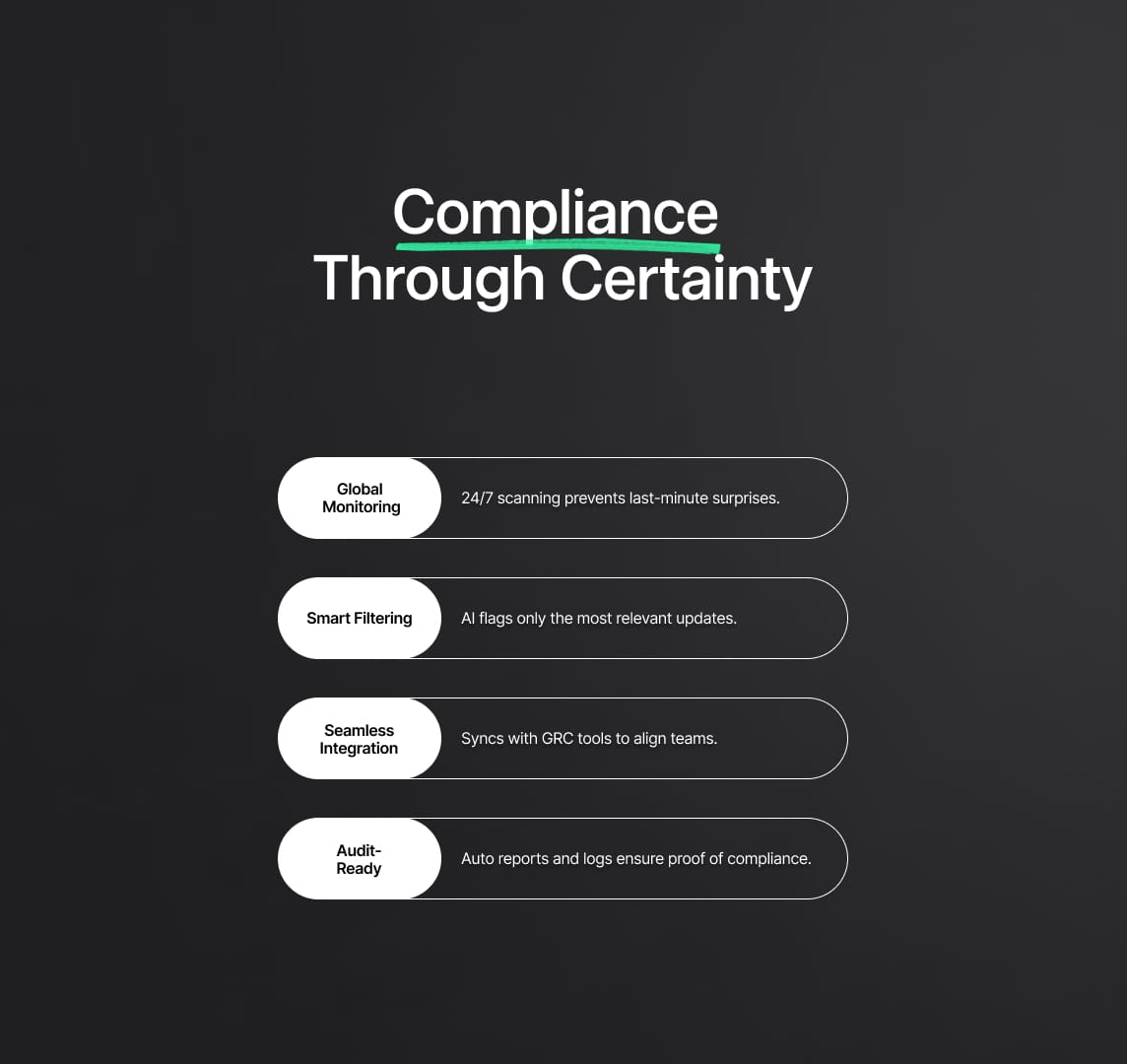
7. Future Developments of Regulatory Horizon Scanning Software
Although today’s Regulatory Horizon Scanning Software solutions excel at real-time updates, comprehensive data analysis, and instant alerts, ongoing shifts in technology and regulatory practices are likely to spur innovative enhancements. Here are several areas where these platforms could advance:
7.1 Earlier Legislative Proposal Tracking
- Expanded Focus on Draft Legislation and Debates
- Monitoring Political Discussions: Future tools might not only track finalized or near-final regulations but also delve into early-stage debates within legislative bodies, committees, and stakeholder meetings. This would enable businesses to identify potential risks or compliance shifts well before they reach official publication.
- Analyzing Committee Hearings and Public Consultations: In many jurisdictions, bills and directives undergo a series of hearings, consultations, and amendments. By capturing these stages, Regulatory Horizon Scanning Software could offer more lead time for organizations to prepare resource allocation, stakeholder communication, and strategic planning.
- Improved Issue Scanning and Impact Forecasting
- Structured Analysis of Policy Trends: As these systems begin to gather data from earlier legislative processes, they may categorize potential new laws by topic (e.g., data privacy, environmental sustainability), providing a more nuanced look at how proposals align with emerging industry trends.
- Industry-Specific Legislative Pipelines: For instance, a healthcare-focused company could set up alerts that flag early drafts related to patient data rules, while a financial institution monitors forthcoming updates to banking regulations. This level of precision enables longer preparation windows and targeted strategy sessions.
Why It Matters
By tracking legislation in its infancy, compliance teams can engage proactively with regulators or industry coalitions, influencing or shaping the final outcome to better align with organizational capabilities.
7.2 Ecosystem Collaboration
- Shared Compliance Data Pools
- Cooperative Regulatory Intelligence: Multiple horizon scanning providers or user communities might combine curated data, resulting in a more holistic compliance view. This pooled intelligence could serve as a central knowledge base, enabling faster cross-industry learning and reducing redundant monitoring efforts.
- Open Standards for Data Exchange: To make collaboration smoother, the field may adopt universal data formats or APIs, allowing different scanning tools to seamlessly communicate updates, commentary, or historical logs. The result is a plug-and-play environment that benefits compliance across various sectors and regions.
- Integrated Compliance Ecosystems
- Advanced GRC Integration: As businesses rely on multiple compliance tools—ranging from risk management platforms to third-party screening services—future horizon scanning solutions could centralize these inputs. This consolidation ensures every compliance stakeholder, from procurement teams to data protection officers, remains aligned on real-time changes.
- Sector-Specific Networks: In highly regulated industries (e.g., pharmaceuticals, finance, aviation), organizations may come together to co-develop best practices and share them openly via horizon scanning solutions, leading to standardized approaches and reducing the overall burden of repeated, isolated compliance efforts.
Why It Matters
Collaborative ecosystems accelerate collective learning. By sharing regulatory intelligence, businesses avoid duplicative monitoring and gain deeper insights into emerging trends—ultimately raising the bar for compliance readiness across entire industries.
7.3 Refined AI-Driven Correlations
- Deeper Contextual Analysis
- Linking Socio-Political Factors: While current software mainly flags factual updates, future solutions may attempt to correlate legislative developments with broader social, economic, or geopolitical events. For example, a spike in cybersecurity breaches might drive forthcoming data protection amendments.
- Identifying Cross-Jurisdictional Similarities: Machine learning could examine patterns in how different countries respond to similar crises (e.g., financial crises, public health emergencies) and highlight common regulatory themes. This approach helps global enterprises anticipate where rules might converge or diverge.
- Augmented Scenario Planning
- Risk Scoring for Emerging Topics: Some advanced systems may offer tools that score the likelihood of certain legislative outcomes. For instance, if multiple parliamentary committees across Europe are discussing stricter carbon emissions targets, the software might flag an “elevated risk” zone for environmental compliance changes.
- Forward-Looking Insights (With Caveats): While more sophisticated analytics could offer glimpses of potential future regulations, it’s vital to note these remain best-effort forecasts, not certainties. True “prediction” requires a balance between historical data, socio-political intelligence, and regulatory precedents—and always carries an inherent degree of uncertainty.
Why It Matters
Enhanced AI-driven correlations can help businesses fine-tune their risk assessment and prioritize compliance investments. Still, it’s crucial to maintain a realistic perspective: these features complement, rather than replace, the core function of providing real-time, confirmed regulatory updates.
A Note on “Predictive” Capabilities
Some Regulatory Horizon Scanning Software vendors may tout “predictive” functions, implying they can foretell future laws. While AI-driven patterns and socio-political cues can suggest where policy might be heading, the primary strength of these tools will likely continue to lie in detecting verified updates and disseminating them in a timely, actionable manner.
Speculative forecasting remains an adjunct to horizon scanning rather than its core mission—particularly given the complexity of legislative processes, shifting political climates, and unforeseen external factors (e.g., global pandemics, sudden economic downturns). It’s essential for businesses to distinguish between reliable, factual updates and long-range speculations that may or may not materialise.
8.Building a Culture of Compliance Through Certainty
Regulations don’t wait for you to catch up—they evolve relentlessly, often spanning multiple jurisdictions and languages. Regulatory Horizon Scanning Software delivers the certainty organizations need to maintain compliance effortlessly:
- Immediate Visibility: Around-the-clock global monitoring prevents last-minute surprises.
- Targeted Accuracy: AI-driven filtering highlights the updates your teams actually need to know.
- Organizational Cohesion: Integration with GRC suites ensures that no department is ever out of sync.
- Evidence-Based Compliance: Automatic reporting and audit trails prove you’re on top of every change, instilling trust among stakeholders and regulators.
In a world where one overlooked rule could undermine years of hard work, taking a proactive, technology-led approach to compliance is no longer optional—it’s mission-critical. By adopting a robust Regulatory Horizon Scanning Software, you embed expertise, authoritativeness, and trustworthiness into your core operations, paving the way for sustainable growth and resilient success in the face of regulatory uncertainty.
Ready to Strengthen Your Compliance Framework?
Explore how Grand Regulatory Horizon Scanning Software empowers you with real-time alerts, deep data categorization, and easy integration—all while laying the groundwork for possible predictive enhancements in the future. Stay agile, stay prepared, and let compliance certainty drive your organization forward.
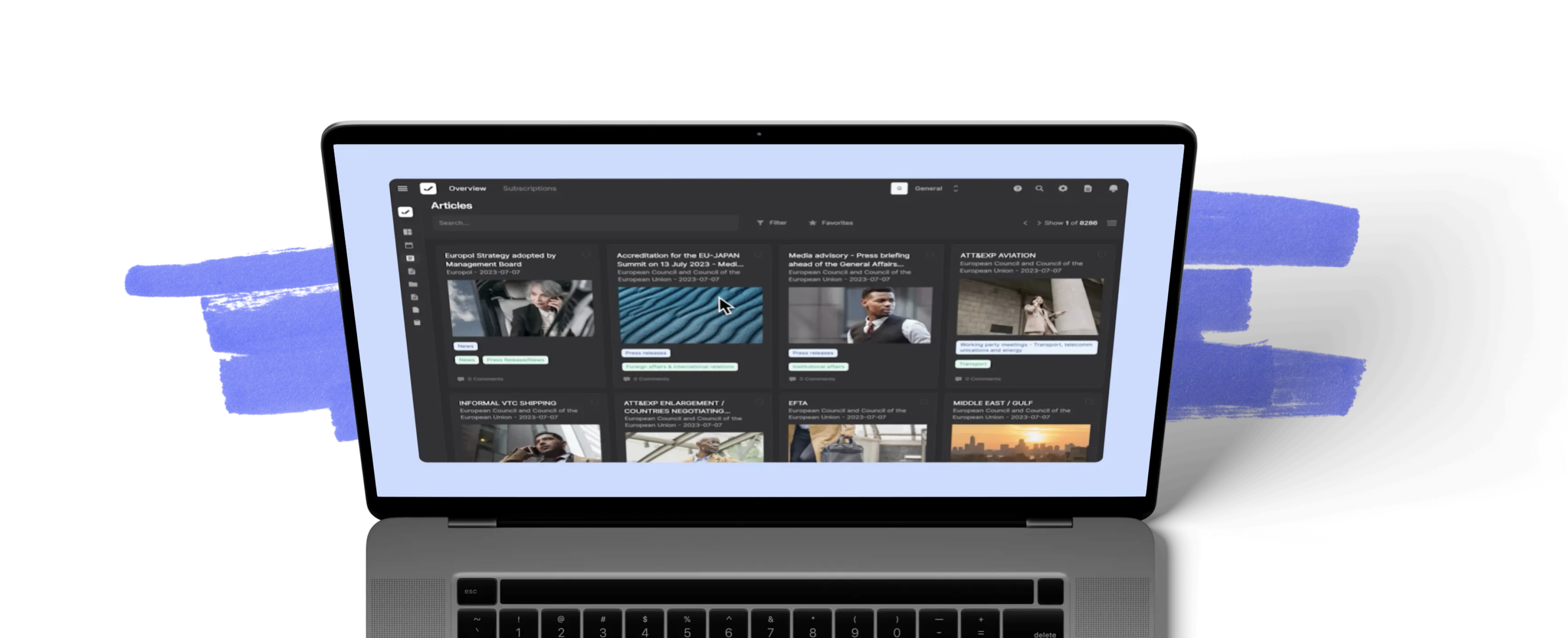
Reduce your
compliance risks


